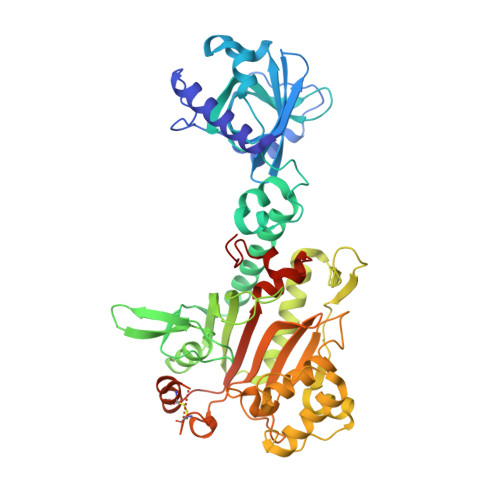Structure-guided conversion from an anaplastic lymphoma kinase inhibitor into Plasmodium lysyl-tRNA synthetase selective inhibitors.
Zhou, J., Xia, M., Huang, Z., Qiao, H., Yang, G., Qian, Y., Li, P., Zhang, Z., Gao, X., Jiang, L., Wang, J., Li, W., Fang, P.(2024) Commun Biol 7: 742-742
- PubMed: 38890421
- DOI: https://doi.org/10.1038/s42003-024-06455-4
- Primary Citation of Related Structures:
8K9S, 8K9U, 8K9V, 8K9W, 8K9X - PubMed Abstract:
Aminoacyl-tRNA synthetases (aaRSs) play a central role in the translation of genetic code, serving as attractive drug targets. Within this family, the lysyl-tRNA synthetase (LysRS) constitutes a promising antimalarial target. ASP3026, an anaplastic lymphoma kinase (ALK) inhibitor was recently identified as a novel Plasmodium falciparum LysRS (PfLysRS) inhibitor. Here, based on cocrystal structures and biochemical experiments, we developed a series of ASP3026 analogues to improve the selectivity and potency of LysRS inhibition. The leading compound 36 showed a dissociation constant of 15.9 nM with PfLysRS. The inhibitory efficacy on PfLysRS and parasites has been enhanced. Covalent attachment of L-lysine to compound 36 resulted in compound 36K3, which exhibited further increased inhibitory activity against PfLysRS but significantly decreased activity against ALK. However, its inhibitory activity against parasites did not improve, suggesting potential future optimization directions. This study presents a new example of derivatization of kinase inhibitors repurposed to inhibit aaRS.
Organizational Affiliation:
School of Chemistry and Materials Science, Hangzhou Institute for Advanced Study, University of Chinese Academy of Sciences, 1 Sub-lane Xiangshan, Hangzhou, 310024, China.

















